Analysis of Leadership Styles in a Manufacturing Company: TMA02 Report
VerifiedAdded on 2019/09/22
|6
|1357
|270
Report
AI Summary
This report analyzes a real-life situation within a manufacturing company in Singapore, focusing on the leadership challenges faced during a new plant opening. The assignment details the project manager's ineffective leadership, which led to unclear goals, team conflicts, and decreased efficiency. The report then applies two theoretical frameworks: the behavioral approach and team leadership theory, to evaluate the situation. The behavioral approach highlights the impact of the leader's actions on employee performance and the importance of balancing task and relationship behaviors. The team leadership theory emphasizes shared leadership and trust within the team. The report discusses the strengths and weaknesses of the project manager, potential solutions, and the impact on stakeholders and the internal/external environment. The analysis underscores the importance of clear communication, employee involvement, and a supportive leadership style to improve team performance and achieve project success. The report concludes by referencing relevant academic sources to support its findings.
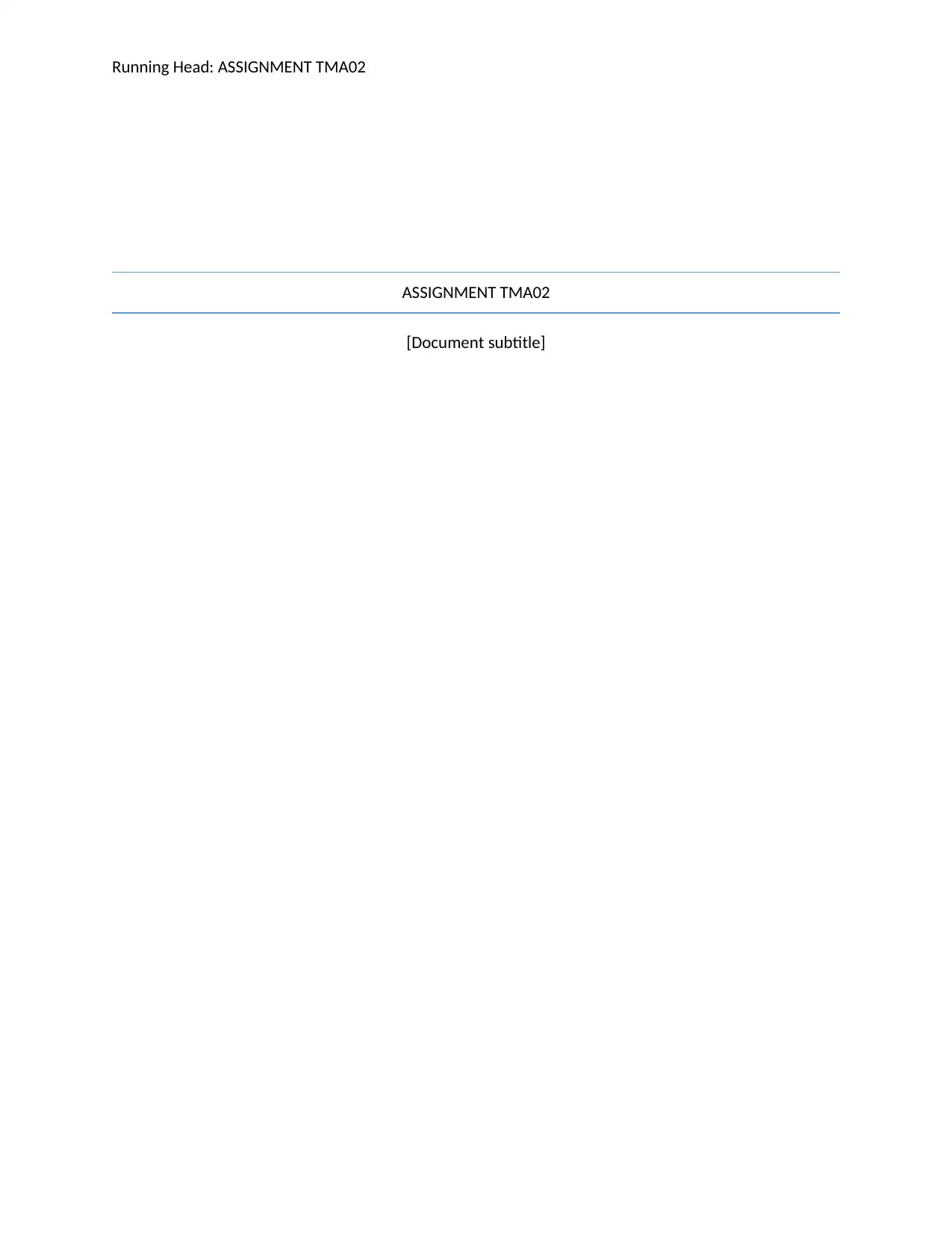
Running Head: ASSIGNMENT TMA02
ASSIGNMENT TMA02
[Document subtitle]
ASSIGNMENT TMA02
[Document subtitle]
Paraphrase This Document
Need a fresh take? Get an instant paraphrase of this document with our AI Paraphraser
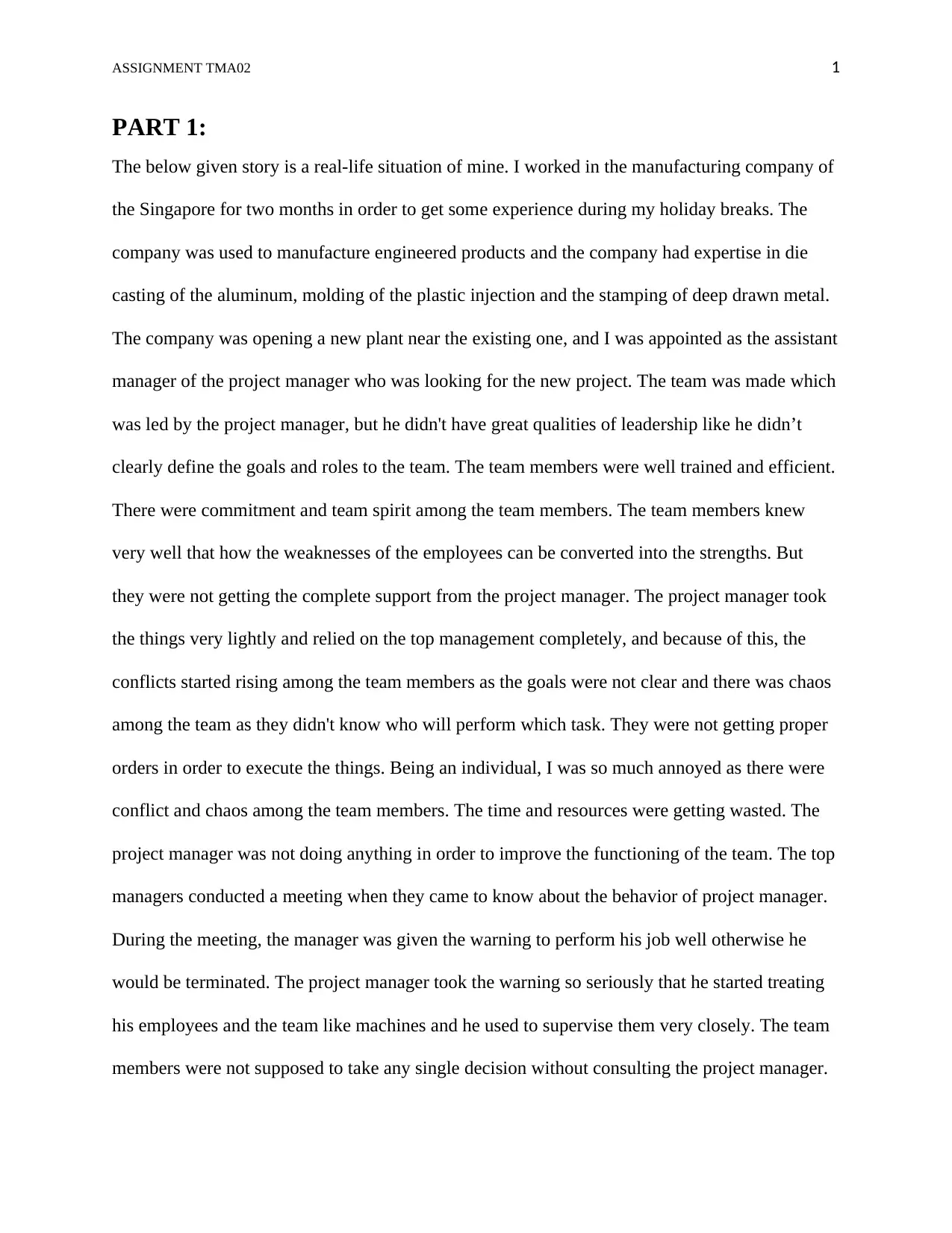
ASSIGNMENT TMA02 1
PART 1:
The below given story is a real-life situation of mine. I worked in the manufacturing company of
the Singapore for two months in order to get some experience during my holiday breaks. The
company was used to manufacture engineered products and the company had expertise in die
casting of the aluminum, molding of the plastic injection and the stamping of deep drawn metal.
The company was opening a new plant near the existing one, and I was appointed as the assistant
manager of the project manager who was looking for the new project. The team was made which
was led by the project manager, but he didn't have great qualities of leadership like he didn’t
clearly define the goals and roles to the team. The team members were well trained and efficient.
There were commitment and team spirit among the team members. The team members knew
very well that how the weaknesses of the employees can be converted into the strengths. But
they were not getting the complete support from the project manager. The project manager took
the things very lightly and relied on the top management completely, and because of this, the
conflicts started rising among the team members as the goals were not clear and there was chaos
among the team as they didn't know who will perform which task. They were not getting proper
orders in order to execute the things. Being an individual, I was so much annoyed as there were
conflict and chaos among the team members. The time and resources were getting wasted. The
project manager was not doing anything in order to improve the functioning of the team. The top
managers conducted a meeting when they came to know about the behavior of project manager.
During the meeting, the manager was given the warning to perform his job well otherwise he
would be terminated. The project manager took the warning so seriously that he started treating
his employees and the team like machines and he used to supervise them very closely. The team
members were not supposed to take any single decision without consulting the project manager.
PART 1:
The below given story is a real-life situation of mine. I worked in the manufacturing company of
the Singapore for two months in order to get some experience during my holiday breaks. The
company was used to manufacture engineered products and the company had expertise in die
casting of the aluminum, molding of the plastic injection and the stamping of deep drawn metal.
The company was opening a new plant near the existing one, and I was appointed as the assistant
manager of the project manager who was looking for the new project. The team was made which
was led by the project manager, but he didn't have great qualities of leadership like he didn’t
clearly define the goals and roles to the team. The team members were well trained and efficient.
There were commitment and team spirit among the team members. The team members knew
very well that how the weaknesses of the employees can be converted into the strengths. But
they were not getting the complete support from the project manager. The project manager took
the things very lightly and relied on the top management completely, and because of this, the
conflicts started rising among the team members as the goals were not clear and there was chaos
among the team as they didn't know who will perform which task. They were not getting proper
orders in order to execute the things. Being an individual, I was so much annoyed as there were
conflict and chaos among the team members. The time and resources were getting wasted. The
project manager was not doing anything in order to improve the functioning of the team. The top
managers conducted a meeting when they came to know about the behavior of project manager.
During the meeting, the manager was given the warning to perform his job well otherwise he
would be terminated. The project manager took the warning so seriously that he started treating
his employees and the team like machines and he used to supervise them very closely. The team
members were not supposed to take any single decision without consulting the project manager.
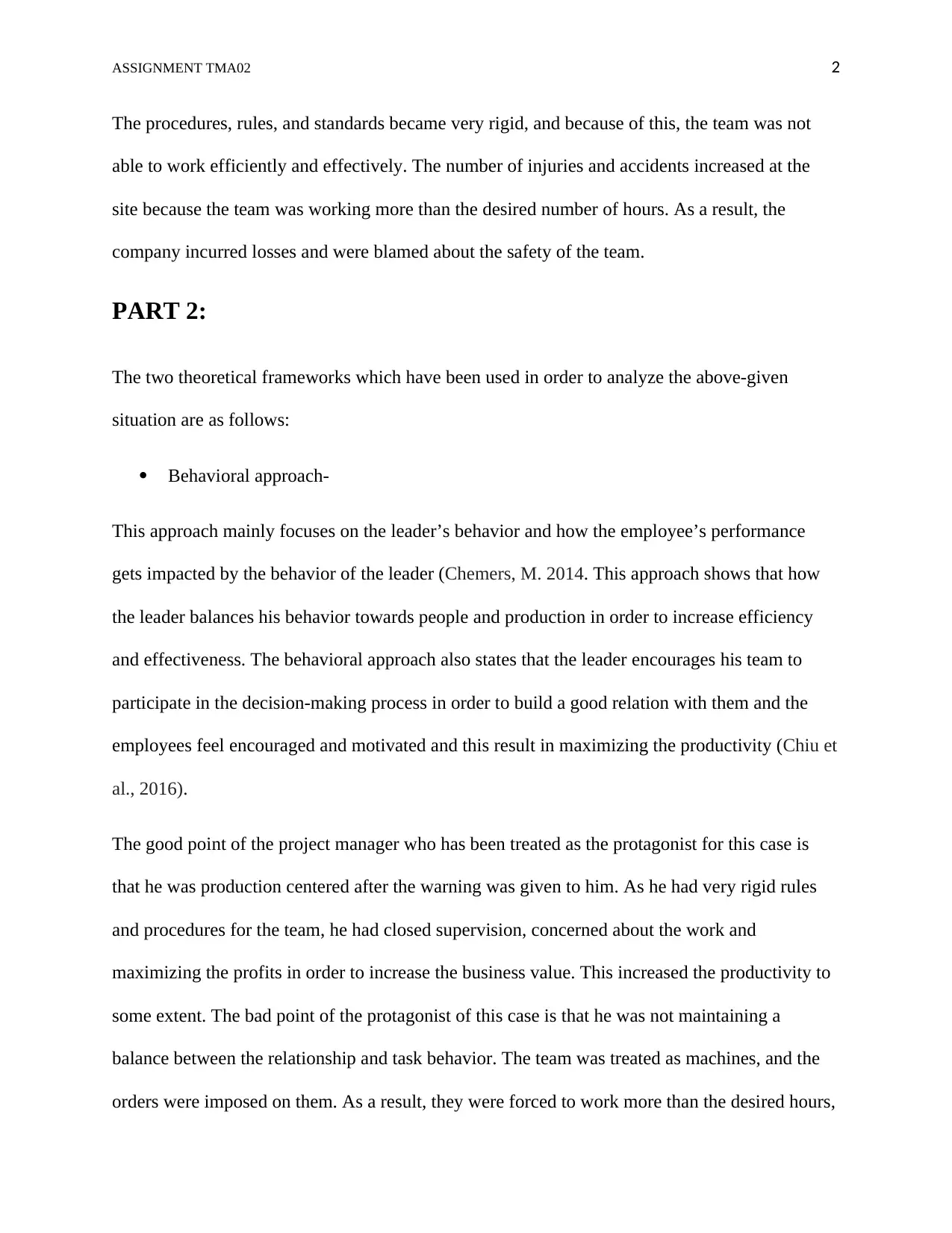
ASSIGNMENT TMA02 2
The procedures, rules, and standards became very rigid, and because of this, the team was not
able to work efficiently and effectively. The number of injuries and accidents increased at the
site because the team was working more than the desired number of hours. As a result, the
company incurred losses and were blamed about the safety of the team.
PART 2:
The two theoretical frameworks which have been used in order to analyze the above-given
situation are as follows:
Behavioral approach-
This approach mainly focuses on the leader’s behavior and how the employee’s performance
gets impacted by the behavior of the leader (Chemers, M. 2014. This approach shows that how
the leader balances his behavior towards people and production in order to increase efficiency
and effectiveness. The behavioral approach also states that the leader encourages his team to
participate in the decision-making process in order to build a good relation with them and the
employees feel encouraged and motivated and this result in maximizing the productivity (Chiu et
al., 2016).
The good point of the project manager who has been treated as the protagonist for this case is
that he was production centered after the warning was given to him. As he had very rigid rules
and procedures for the team, he had closed supervision, concerned about the work and
maximizing the profits in order to increase the business value. This increased the productivity to
some extent. The bad point of the protagonist of this case is that he was not maintaining a
balance between the relationship and task behavior. The team was treated as machines, and the
orders were imposed on them. As a result, they were forced to work more than the desired hours,
The procedures, rules, and standards became very rigid, and because of this, the team was not
able to work efficiently and effectively. The number of injuries and accidents increased at the
site because the team was working more than the desired number of hours. As a result, the
company incurred losses and were blamed about the safety of the team.
PART 2:
The two theoretical frameworks which have been used in order to analyze the above-given
situation are as follows:
Behavioral approach-
This approach mainly focuses on the leader’s behavior and how the employee’s performance
gets impacted by the behavior of the leader (Chemers, M. 2014. This approach shows that how
the leader balances his behavior towards people and production in order to increase efficiency
and effectiveness. The behavioral approach also states that the leader encourages his team to
participate in the decision-making process in order to build a good relation with them and the
employees feel encouraged and motivated and this result in maximizing the productivity (Chiu et
al., 2016).
The good point of the project manager who has been treated as the protagonist for this case is
that he was production centered after the warning was given to him. As he had very rigid rules
and procedures for the team, he had closed supervision, concerned about the work and
maximizing the profits in order to increase the business value. This increased the productivity to
some extent. The bad point of the protagonist of this case is that he was not maintaining a
balance between the relationship and task behavior. The team was treated as machines, and the
orders were imposed on them. As a result, they were forced to work more than the desired hours,
⊘ This is a preview!⊘
Do you want full access?
Subscribe today to unlock all pages.

Trusted by 1+ million students worldwide
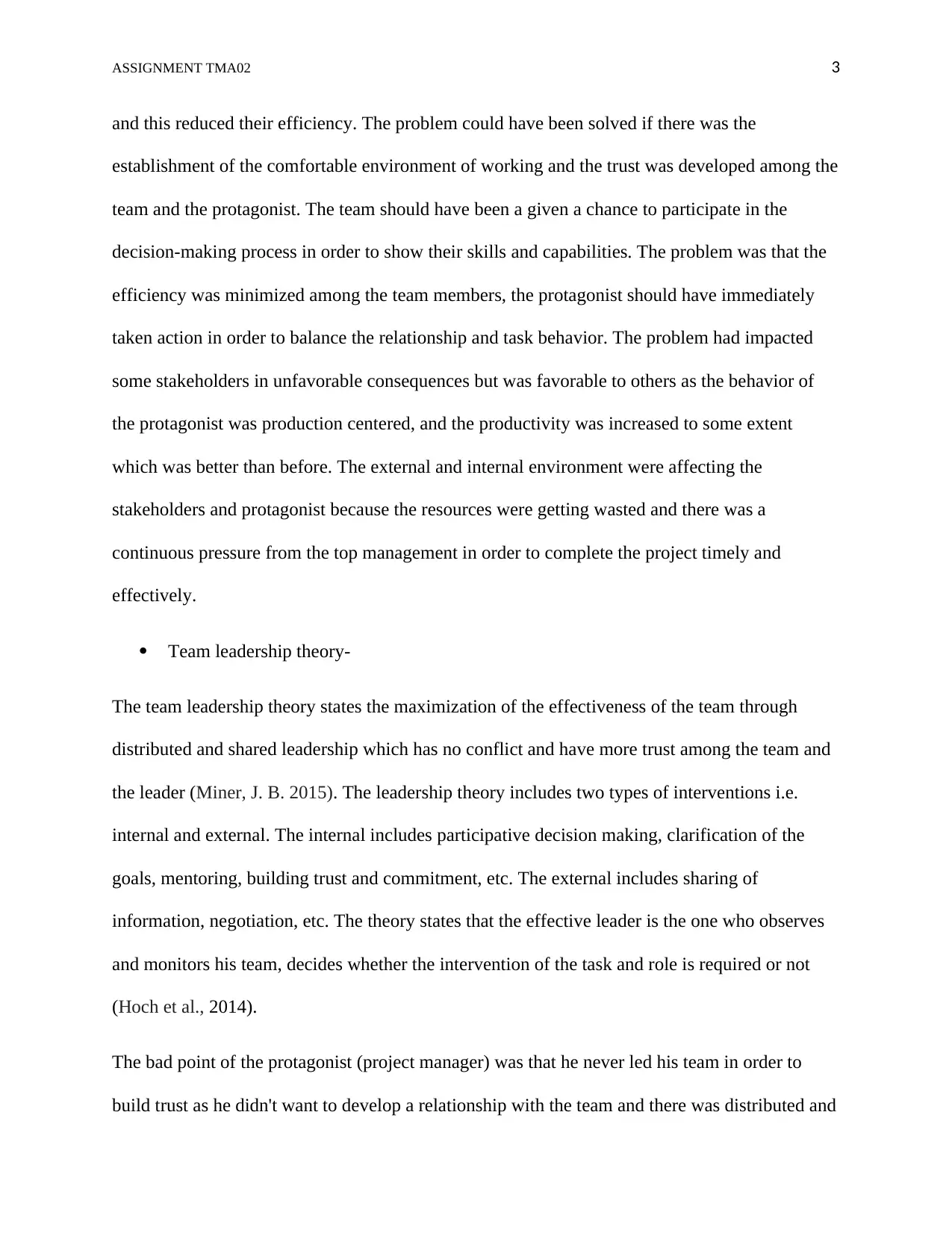
ASSIGNMENT TMA02 3
and this reduced their efficiency. The problem could have been solved if there was the
establishment of the comfortable environment of working and the trust was developed among the
team and the protagonist. The team should have been a given a chance to participate in the
decision-making process in order to show their skills and capabilities. The problem was that the
efficiency was minimized among the team members, the protagonist should have immediately
taken action in order to balance the relationship and task behavior. The problem had impacted
some stakeholders in unfavorable consequences but was favorable to others as the behavior of
the protagonist was production centered, and the productivity was increased to some extent
which was better than before. The external and internal environment were affecting the
stakeholders and protagonist because the resources were getting wasted and there was a
continuous pressure from the top management in order to complete the project timely and
effectively.
Team leadership theory-
The team leadership theory states the maximization of the effectiveness of the team through
distributed and shared leadership which has no conflict and have more trust among the team and
the leader (Miner, J. B. 2015). The leadership theory includes two types of interventions i.e.
internal and external. The internal includes participative decision making, clarification of the
goals, mentoring, building trust and commitment, etc. The external includes sharing of
information, negotiation, etc. The theory states that the effective leader is the one who observes
and monitors his team, decides whether the intervention of the task and role is required or not
(Hoch et al., 2014).
The bad point of the protagonist (project manager) was that he never led his team in order to
build trust as he didn't want to develop a relationship with the team and there was distributed and
and this reduced their efficiency. The problem could have been solved if there was the
establishment of the comfortable environment of working and the trust was developed among the
team and the protagonist. The team should have been a given a chance to participate in the
decision-making process in order to show their skills and capabilities. The problem was that the
efficiency was minimized among the team members, the protagonist should have immediately
taken action in order to balance the relationship and task behavior. The problem had impacted
some stakeholders in unfavorable consequences but was favorable to others as the behavior of
the protagonist was production centered, and the productivity was increased to some extent
which was better than before. The external and internal environment were affecting the
stakeholders and protagonist because the resources were getting wasted and there was a
continuous pressure from the top management in order to complete the project timely and
effectively.
Team leadership theory-
The team leadership theory states the maximization of the effectiveness of the team through
distributed and shared leadership which has no conflict and have more trust among the team and
the leader (Miner, J. B. 2015). The leadership theory includes two types of interventions i.e.
internal and external. The internal includes participative decision making, clarification of the
goals, mentoring, building trust and commitment, etc. The external includes sharing of
information, negotiation, etc. The theory states that the effective leader is the one who observes
and monitors his team, decides whether the intervention of the task and role is required or not
(Hoch et al., 2014).
The bad point of the protagonist (project manager) was that he never led his team in order to
build trust as he didn't want to develop a relationship with the team and there was distributed and
Paraphrase This Document
Need a fresh take? Get an instant paraphrase of this document with our AI Paraphraser
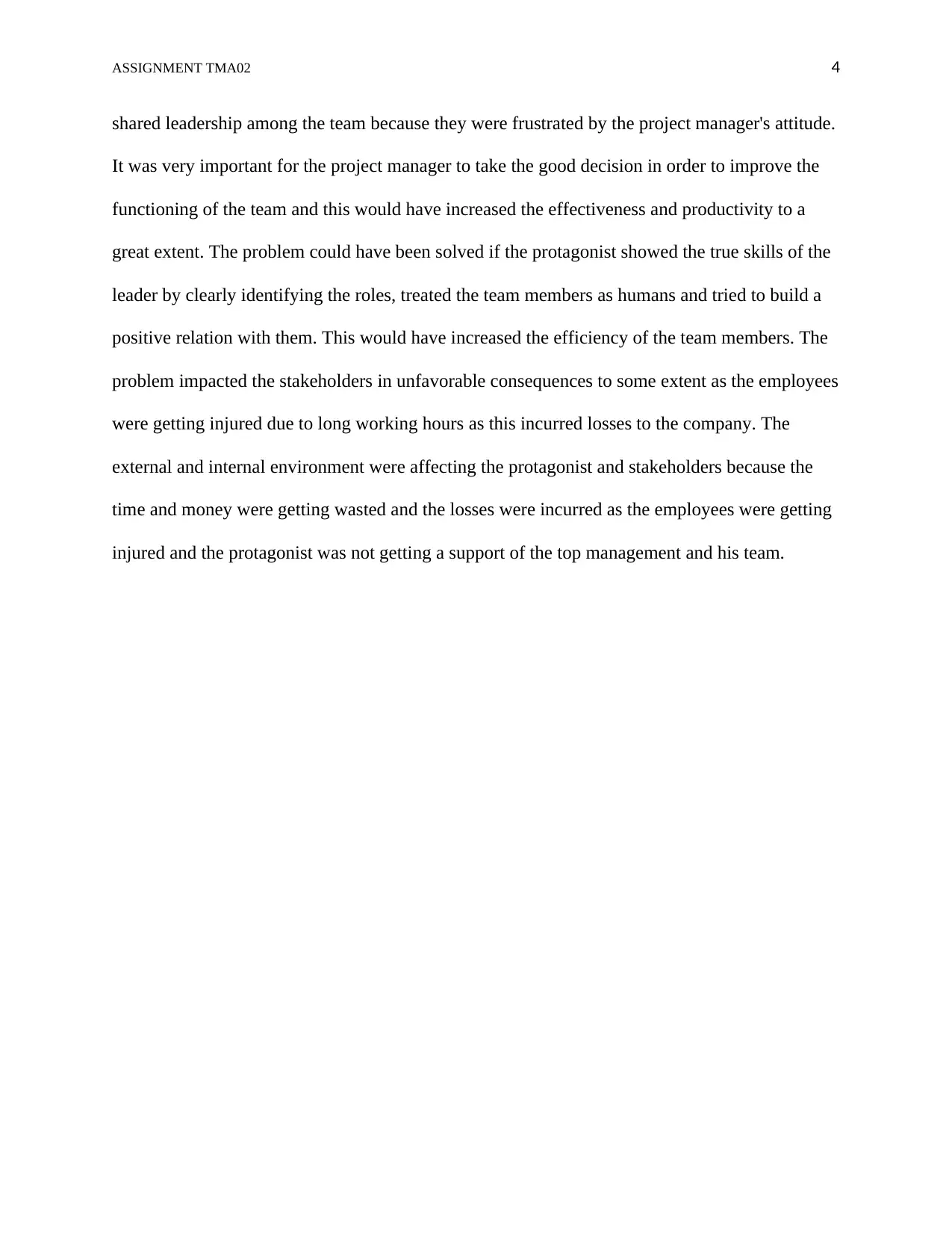
ASSIGNMENT TMA02 4
shared leadership among the team because they were frustrated by the project manager's attitude.
It was very important for the project manager to take the good decision in order to improve the
functioning of the team and this would have increased the effectiveness and productivity to a
great extent. The problem could have been solved if the protagonist showed the true skills of the
leader by clearly identifying the roles, treated the team members as humans and tried to build a
positive relation with them. This would have increased the efficiency of the team members. The
problem impacted the stakeholders in unfavorable consequences to some extent as the employees
were getting injured due to long working hours as this incurred losses to the company. The
external and internal environment were affecting the protagonist and stakeholders because the
time and money were getting wasted and the losses were incurred as the employees were getting
injured and the protagonist was not getting a support of the top management and his team.
shared leadership among the team because they were frustrated by the project manager's attitude.
It was very important for the project manager to take the good decision in order to improve the
functioning of the team and this would have increased the effectiveness and productivity to a
great extent. The problem could have been solved if the protagonist showed the true skills of the
leader by clearly identifying the roles, treated the team members as humans and tried to build a
positive relation with them. This would have increased the efficiency of the team members. The
problem impacted the stakeholders in unfavorable consequences to some extent as the employees
were getting injured due to long working hours as this incurred losses to the company. The
external and internal environment were affecting the protagonist and stakeholders because the
time and money were getting wasted and the losses were incurred as the employees were getting
injured and the protagonist was not getting a support of the top management and his team.
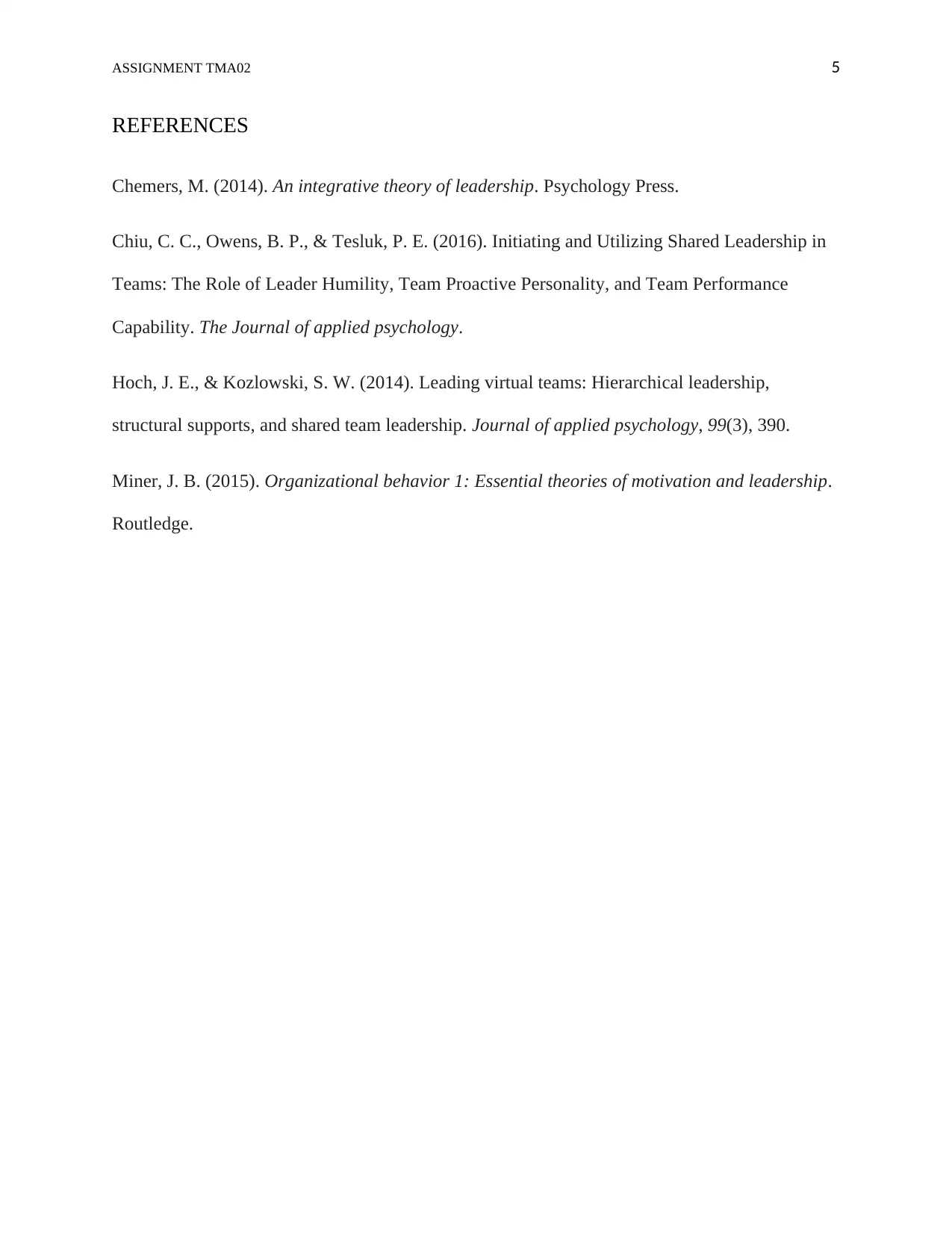
ASSIGNMENT TMA02 5
REFERENCES
Chemers, M. (2014). An integrative theory of leadership. Psychology Press.
Chiu, C. C., Owens, B. P., & Tesluk, P. E. (2016). Initiating and Utilizing Shared Leadership in
Teams: The Role of Leader Humility, Team Proactive Personality, and Team Performance
Capability. The Journal of applied psychology.
Hoch, J. E., & Kozlowski, S. W. (2014). Leading virtual teams: Hierarchical leadership,
structural supports, and shared team leadership. Journal of applied psychology, 99(3), 390.
Miner, J. B. (2015). Organizational behavior 1: Essential theories of motivation and leadership.
Routledge.
REFERENCES
Chemers, M. (2014). An integrative theory of leadership. Psychology Press.
Chiu, C. C., Owens, B. P., & Tesluk, P. E. (2016). Initiating and Utilizing Shared Leadership in
Teams: The Role of Leader Humility, Team Proactive Personality, and Team Performance
Capability. The Journal of applied psychology.
Hoch, J. E., & Kozlowski, S. W. (2014). Leading virtual teams: Hierarchical leadership,
structural supports, and shared team leadership. Journal of applied psychology, 99(3), 390.
Miner, J. B. (2015). Organizational behavior 1: Essential theories of motivation and leadership.
Routledge.
⊘ This is a preview!⊘
Do you want full access?
Subscribe today to unlock all pages.

Trusted by 1+ million students worldwide
1 out of 6
Related Documents
Your All-in-One AI-Powered Toolkit for Academic Success.
+13062052269
info@desklib.com
Available 24*7 on WhatsApp / Email
![[object Object]](/_next/static/media/star-bottom.7253800d.svg)
Unlock your academic potential
Copyright © 2020–2025 A2Z Services. All Rights Reserved. Developed and managed by ZUCOL.




